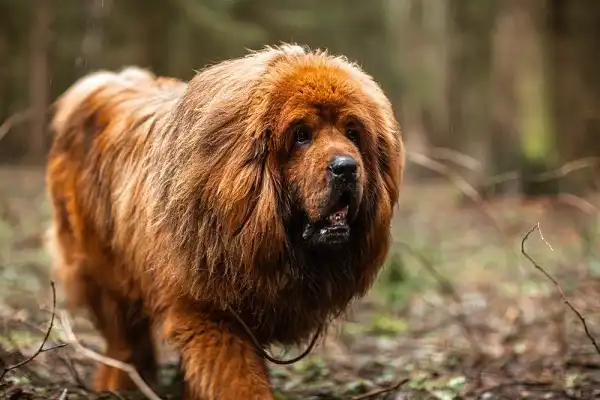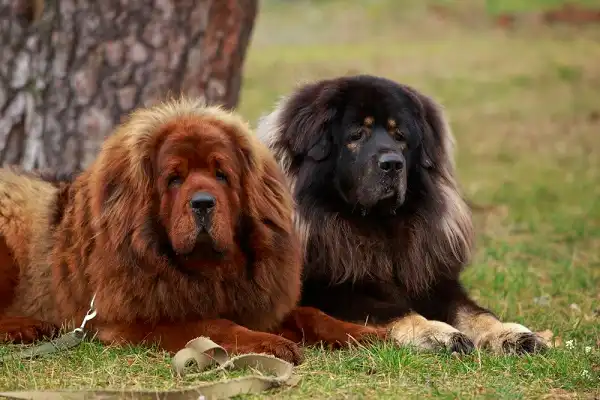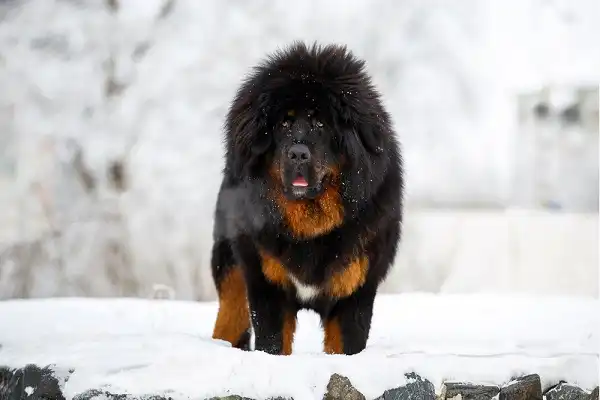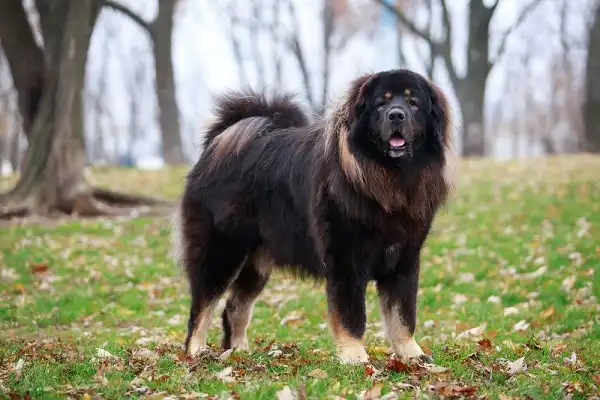The Tibetan Mastiff is an ancient breed that can trace its ancestry back more than 2,000 years. It was originally bred as a guard dog to protect the nomadic tribes of Tibet from predators and intruders. These large dogs are imposing-looking animals with a reputation for being courageous and fierce defenders of their packs if necessary. They also have strong protective instincts which make them excellent family companions – both loyal and affectionate to those who care for them. Despite their intimidating size, temperament, and muzzle-length coats, Tibetan mastiffs are actually gentle giants and often form extremely close bonds with members of their human family. If you’re interested in learning more about this majestic breed, read on!

Tibetan Mastiff Description
The Tibetan Mastiff is a formidable breed that is steeped in rich history and tradition. These dogs are known for their imposing size, as well as their striking appearance. Their thick, dense coats are an iconic feature of the breed and can range from black, brown, and blue, to shades of gold, red, and cream. Beyond their impressive physical stature, Tibetan Mastiffs are renowned for their loyal and protective nature. They have a strong sense of territoriality and are fiercely devoted to their families. In ancient Tibet, they were used primarily as guard dogs, tasked with protecting the nomadic tribes from intruders and predators.
Tibetan Mastiff Habitat
The Tibetan Mastiff, as its name suggests, hails from the Tibetan Plateau, where it was originally bred to protect nomadic tribes from predators and intruders. This breed thrives in cold, high-altitude environments, where their thick, double-layered coats provide insulation from harsh weather conditions. These dogs are well-suited to living in spacious outdoor environments, where they can roam and exert their natural instinct to guard and protect their territory. However, with proper training and socialization, Tibetan Mastiffs can also adapt to indoor living arrangements, provided they have ample space to move around. It’s worth noting that Tibetan Mastiffs require plenty of exercise and stimulation, as they have a naturally independent and curious nature. Daily walks, as well as opportunities to engage in interactive play and training, are essential to keeping these dogs healthy and content.
Tibetan Mastiff Diet
The Mastiff is a majestic and impressive breed that requires proper nutrition and a well-balanced diet to maintain its health and vitality. Like all dogs, the Tibetan Mastiff relies on a diet that is rich in protein, healthy fats, and essential vitamins and minerals. When selecting food for your Tibetan Mastiff, it’s important to choose a high-quality, premium dog food that is designed for large breed dogs. This will ensure that your dog receives the optimal balance of nutrients and calories to support their growth and development. Protein is one of the most important components of a Tibetan Mastiff’s diet, as it provides the essential building blocks for strong muscles and healthy tissues. Look for dog food that contains real meat as the first ingredient, such as chicken, beef, or lamb.
Avoid dog foods that list by-product meals or meat meals as the primary protein source, as these ingredients are of lower quality and may contain additives that can be harmful to your dog’s health. Healthy fats are also an essential part of a Tibetan Mastiff’s diet. These fats provide energy, promote healthy skin and coat, and support the immune system. Look for dog foods that contain healthy sources of fat, such as fish oil, flaxseed, or chicken fat. In addition to protein and healthy fats, a Tibetan Mastiff’s diet should also include plenty of fresh fruits and vegetables. These foods provide essential vitamins and minerals, as well as fiber to support digestive health. Look for dog foods that contain a variety of nutrient-rich fruits and vegetables, such as sweet potatoes, peas, apples, and blueberries.

Tibetan Mastiff Size
Tibetan Mastiffs are one of the largest dog breeds in the world, with an average height of 26-29 inches (66-74 cm) for males and 24-27 inches (61-68 cm) for females. The weight of an adult Tibetan Mastiff can range from 100-160 pounds (45-73 kg), with some individuals even weighing over 200 pounds (90 kg). Their sturdy build, powerful muscles, and massive bone structure give them the physical strength to serve as guardians of their homes and family.
Tibetan Mastiff Lifespan
The Tibetan Mastiff is a magnificent breed of dog known for its impressive size and regal appearance. One question that often arises is how long they can live. While there is no exact answer to this question, with proper care and attention, these dogs can live up to 14 years or more. However, their lifespan can be affected by various factors such as genetics, nutrition, exercise, and living conditions. Genetics is a critical factor in determining a Tibetan Mastiff’s lifespan. Good breeding practices that emphasize the health and longevity of the breed can help ensure that dogs live long and healthy life. Responsible breeders carefully select breeding stock to avoid passing on any genetic health issues that may decrease a dog’s lifespan. Nutrition is also an essential aspect of a Tibetan Mastiff’s lifespan. A well-balanced diet that meets their daily nutritional needs is crucial for maintaining optimal health and longevity. Exercise and living conditions also have a significant impact on a Tibetan Mastiff’s lifespan. These dogs require plenty of exercise and mental stimulation to stay healthy and motivated. Adequate exercise helps prevent obesity and other health issues that can decrease a dog’s lifespan.
Tibetan Mastiff Behavior
The Tibetan Mastiff is not only renowned for its imposing size and regal appearance but also for its unique behavior shaped by centuries of breeding for the role of guardian and protector. This breed is known for being fiercely loyal and protective of its family and territory. They are alert and always aware of their surroundings, quick to sound the alarm at any perceived danger. Due to their independent nature, Tibetan Mastiffs can be stubborn and resistant to training, requiring a patient and experienced handler to establish boundaries and reinforce positive behavior. Socialization from a young age is also crucial to prevent any aggressive tendencies towards strangers or other animals. While they may seem intimidating to some, Tibetan Mastiffs are gentle and affectionate with their loved ones, often displaying a calm and even-tempered demeanor. They are not typically high-energy dogs, preferring to lounge and observe their surroundings unless provoked or challenged.

Tibetan Mastiff Speed
Tibetan Mastiffs are not known for their speed. In fact, they are one of the slowest dog breeds, with a top speed of only 12 miles per hour. This is due to their large size and heavy build, which make them better suited for guarding and protection rather than agility and speed. While they may not be fast runners, Tibetan Mastiffs are incredibly strong and can easily overpower an intruder or predator. Their powerful jaws and muscular bodies make them formidable opponents, capable of taking down much larger animals if necessary. In addition to their physical strength, Tibetan Mastiffs have exceptional endurance and can cover long distances over rough terrain without becoming fatigued. This is an important trait for a breed that was originally used for herding and protecting livestock in the harsh and rugged terrain of the Himalayas.
Tibetan Mastiff Hunting
Tibetan Mastiffs were not primarily bred for hunting but as guardians and protectors. However, their history as working dogs in the rugged terrain of the Himalayas has given them the instincts and physical abilities necessary for hunting. Their large size, physical strength, and exceptional endurance make them capable of taking down large animals, such as bears or wolves, without becoming fatigued. Their thick, weather-resistant coat also allows them to tolerate the frigid temperatures of their native environment. While they may not be as fast or agile as other hunting breeds, Tibetan Mastiffs have a keen sense of smell and can track prey over long distances. They are also intelligent and adaptable, able to quickly learn and adjust to new environments and hunting techniques. Despite their innate hunting abilities, it is important to note that Tibetan Mastiffs should not be trained for hunting without proper supervision and guidance. Their strong protective instincts could cause them to become aggressive towards other animals or even humans if not properly directed.
Tibetan Mastiff Grooming and Care
Like all breeds, the Tibetan Mastiff requires regular grooming and care in order to stay healthy and happy. Their thick coat should be groomed regularly, using a slicker brush or comb to remove dead hair and prevent tangles and mats. It is also important to check for fleas and ticks as these parasites can cause skin irritations, as well as spread dangerous diseases. A bath every few months with a high-quality shampoo will help keep their coat clean and shiny. In addition to their physical health, it is also important to provide proper mental stimulation for your Tibetan Mastiff. Regular playtime, walks, and training sessions will help keep them physically fit while providing mental stimulation that helps prevent boredom-related issues like destructive behavior.

Tibetan Mastiff Health issues
Like all dogs, the Tibetan Mastiff is prone to certain health issues. Common ailments include skin allergies, hip dysplasia, eye problems, and bloat or gastric torsion. Regular vet checkups are essential for maintaining their health and catching any potential issues early on. The Tibetan Mastiff is an ancient breed that has been used as guard dog by families and communities for centuries. With the right training, socialization, and care they can make devoted companions who will be loyal protectors of their people. They possess a strong protective instinct and physical capabilities that make them ideal guardians, while their keen sense of smell and endurance enable them to be capable hunters when properly trained. Regular vet checkups and grooming are essential for maintaining your Tibetan Mastiff’s health and making sure they look their best.
Conclusion
Tibetan Mastiffs are a large and powerful breed with an impressive history as loyal protectors and guardians. They are not known for their speed, but they make up for it with their strength, endurance, agility, and sharp hunting instincts. As long as proper training is provided, Tibetan Mastiffs can make loving and devoted companions that also serve as valuable assets to any family or community in need of a guardian. It is important to remember that while Tibetan Mastiffs possess many desirable traits, they still require special attention and care to ensure they reach their full potential. Their strong protective instincts must be properly directed towards productive activities such as herding or guarding in order to avoid the risks associated with aggressive behavior. With the
Frequently Asked Question


